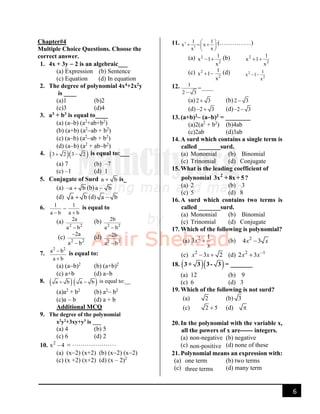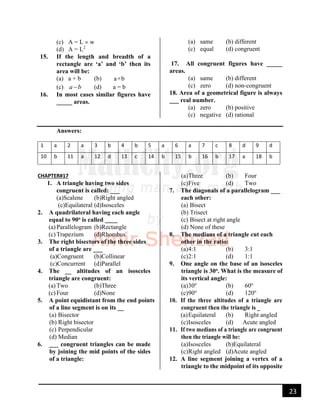The document consists of multiple-choice questions (MCQs) on various mathematical topics, including matrices, logarithms, and properties of numbers, designed for 9th-grade students. Each question offers several answer options, and the document also provides correct answers for the included questions. It covers fundamental concepts in mathematical operations and properties related to matrices and logarithmic functions.
![1
MathCity.org
Merging man and maths
Multiple Choice Questions (MCQs)
Mathematics (Science Group): 9th
Written by Amir Shehzad, Version: 1.0
CHAPTER NO #1
1. The order of matrix [2 1] is …
(a) 2-by-1 (b) 1-by-2
(c) 1-by-1 (d) 2-by-2
2.
2 0
0 2
is called ……. Matrix.
(a) zero (b) unit
(c) scalar (d) singular
3. Which is order of a square matrix?
(a) 2-by-2 (b) 1-by-2
(c) 2-by-1 (d) 3-by-2
4. Which is order of a rectangular
matrix?
(a) 2-by-2 (b) 4-by-4
(c) 2-by-1 (d) 3-by-3
5. Order of transpose of
2 1
0 1
3 2
is …
(a) 3-by-2 (b) 2-by-3
(c) 1-by-3 (d) 3-by-1
6. Adjoint of
1 2
0 1
−
is ………
(a)
1 2
0 1
− −
(b)
1 2
0 1
−
−
(c)
1 2
0 1
−
−
(d)
1 0
2 1
−
7. If
2 6
0
3 x
= , then x is equal to
(a) 9 (b) –6
(c) 6 (d) –9
8. Product of [x y]
2
1
−
is ……..
(a)
2x y
+ (b)
x 2y
−
(c)
2x y
− (d)
x 2y
+
9.
-1 -2 1 0
If X+ =
0 -1 0 1
thenXisequalto.........
(a)
2 2
2 0
(b)
0 2
2 2
(c)
2 0
0 2
(d)
2 2
0 2
Additional MCQ
10. The idea of a matrices was given by:__
(a) Arthur Cayley (b) Leonard Euler
(c) Henry Briggs (d) John Napier
11. If
1 2
A
3 4
−
=
then −A = ______
(a) 1 2
3 4
−
− −
(b) 1 2
3 4
−
− −
(c) 1 2
3 4
(d) 1 2
3 4
−
−
12. A square matrix is symmetric if ___
(a) At
= A (b) A-1
= A
(c) (At
)t
= −At
(d) At
= – A
13. A square matrix is skew-symmetric if:
(a) At
= −A (b) A-1
= −A](https://image.slidesharecdn.com/9th-science-mcqs-ptb-240514044102-cf0559f1/85/Class-9th-Mcq-for-Preparing-Exams-Maths-1-320.jpg)























